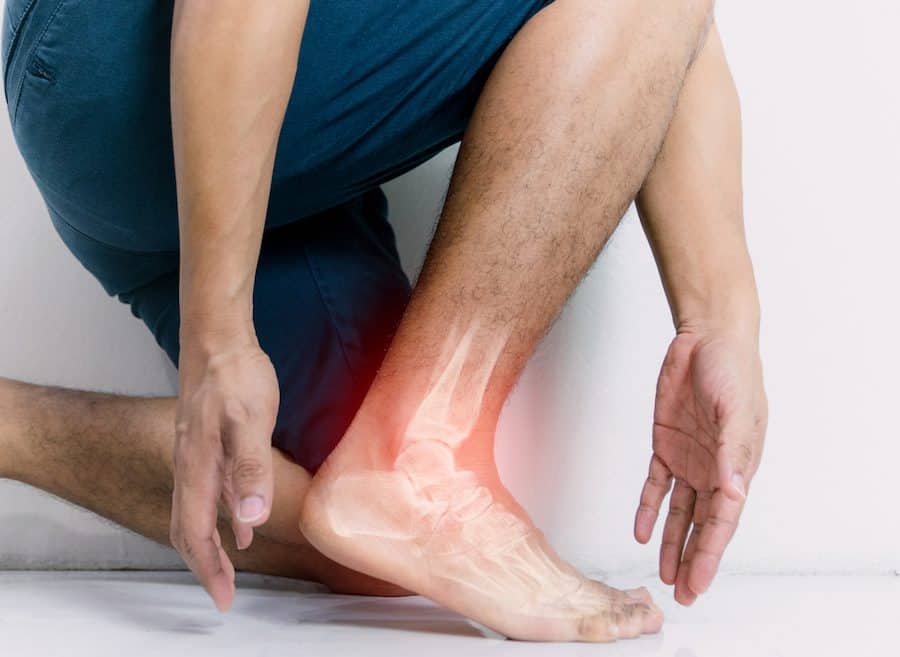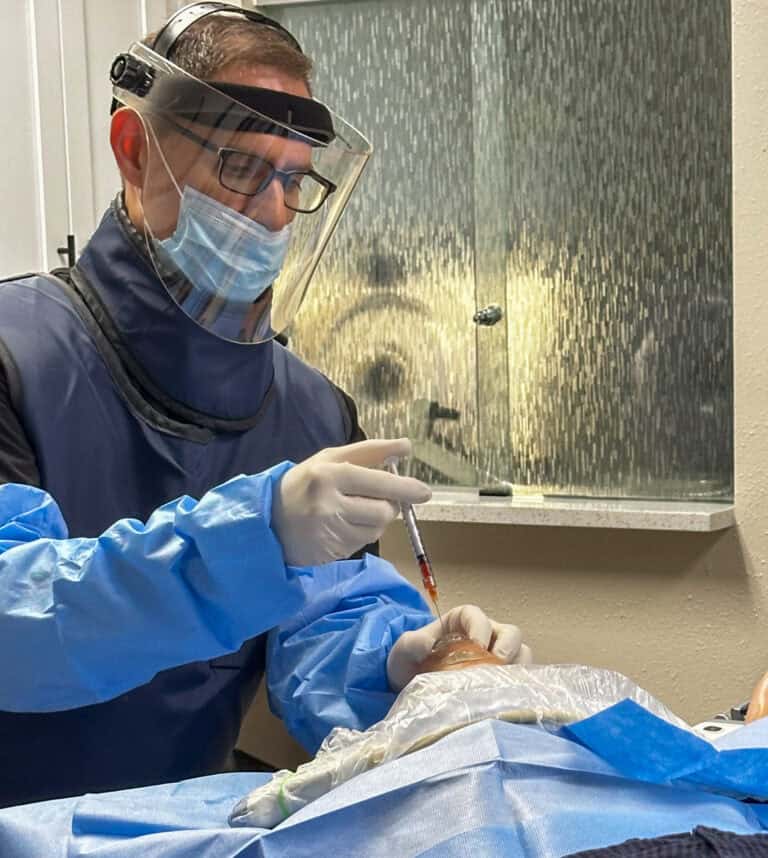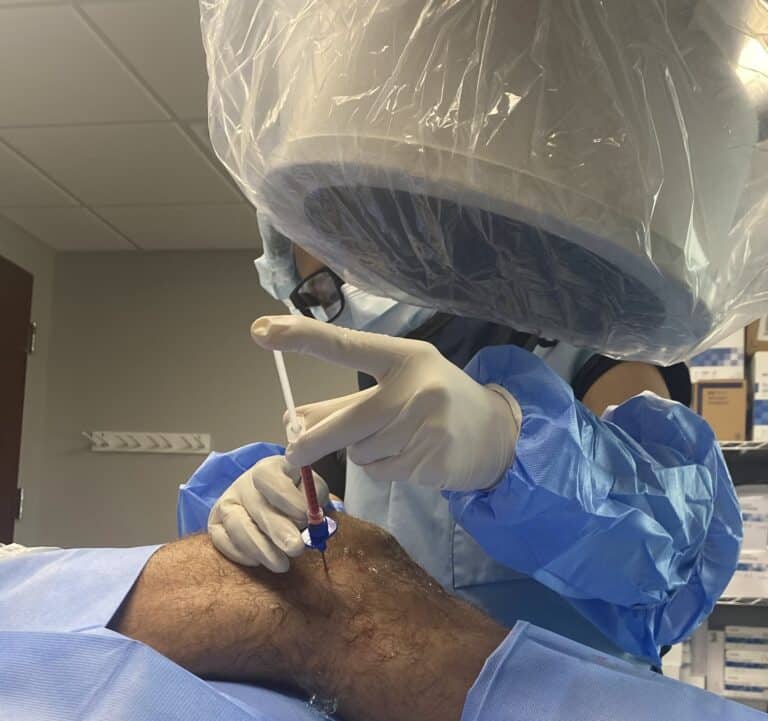The foot and ankle is a very intricate system in the lower leg. The ankle/foot complex consists of 26 bones, 33 joint articulations, and a huge number of tiny muscles, tendons and ligaments. Another important component of the foot and ankle is the sensory or proprioceptive system that has a huge impact on postural stability and dynamic gait patterns.
This beautiful, yet intricate part of the body tends to be a pretty common victim of injury, namely ankle sprains. The most common type of ankle sprain is called an “inversion sprain,” which is when your ankle rolls inward. This particular type of ankle sprain involves the ligaments of the outer side of the ankle.
What are Ankle Ligament Sprains?
A ligament is a tissue that connects bone to bone. It is elastic, and has the ability to stretch and recoil, but oftentimes an ankle sprain takes this stretch beyond its limit and causes overstretching or tearing of the ligaments.
The image below illustrates the three primary ligaments in the outside of the ankle that can be involved in an ankle sprain:
- Anterior Talofibular Ligament (ATFL)- connecting the fibula to the front of the talus
- Posterior Talofibular Ligament (PTFL)- connecting the fibula to the back of the talus
- Calcaneofibular Ligament (CFL)- connecting the fibula to the calcaneus, or heel bone.
When someone rolls their ankle in an inversion sprain, these ligaments are the most vulnerable because they are the outermost stabilizing structures. In the case of a sprain, there are grades of damage, Grades 1-3 respectively, describing the damage to the ligament:
- Grade 1: Overstretched ligament, no tear
- Grade 2: Partial ligament tear
- Grade 3: Complete ligament tear
In the case of Grade 1 or 2, even though the ligament isn’t completely torn, the integrity of the ligament has been affected and is no longer capable of adequately stabilizing and protecting the ankle joint.
The Subsystems and Why Ligaments Matter
As mentioned above, the foot and ankle comprises a huge number of components, but what merits even more of our attention is the functional relationship between all of the bones, ligaments, muscles and articulations. This functional relationship is illustrated below, showing the interconnected work between the passive subsystem, active subsystem and neural subsystem.
The passive subsystem are the ligaments that support the structure of the foot, the active subsystem are the muscles that support the stability and motion of the foot, and the neural subsystem is the sensory aspect of how the foot senses, feels and moves through gait and balance. The integrity of each subsystem is dependent on the integrity of the other two.
So, in circling back to our ankle sprain, if the ligaments in a grade 1 or 2 ankle sprain then are left in their overstretched state, the passive subsystem is malfunctioning, causing the active and neural function of the foot to be compromised as well.
Ankle Ligament Sub-Failure
Ankle ligament sub-failure is a term to describe what happens in the ankle-foot complex when a ligament is too lax or loose to do its job. Traditional orthopedic surgeons would see anything less than a grade 3 tear as something not needing surgical repair, but then the compromised ligaments are left untreated, affecting the overall ankle integrity.
If a loose ligament is present in the ankle joint long-term, the joint complex is subjected to repetitive micro-trauma, or tiny imperceptible movements, in the joint where no movement is supposed to occur. This micro-movement puts undue wear and tear on the cartilage of the ankle joint, but also can lead to arthritis. Painful arthritis can be developed because the way the body handles these repetitive micro-movements is through its favorite stability mechanism: depositing new bone to that area.
In fact, researchers in Amsterdam explored the prevalence of cartilage damage in patients with lateral ankle instability or loose ligaments. They discovered that 32%, or one third, of patients demonstrated a cartilage lesion on their MRI.
The Regenexx Alternative
If the ankle was unstable, what would the treatment look like? Below is a screenshot from a diagnostic ultrasound looking at the ATF ligament in the outer ankle. You can see the image in the left has straight lines and also the path from the left bone to the right bone is short, picturing a healthy ligament that is of its proper length and not overstretched. Now, if you look at the image on the right, the ATFL is traced as an elongated arch from one bone to the other. Also, this ligament looks thickened relative to the normal ligament in the left image.
In the traditional orthopedic setting, the doctor would not surgically repair this ankle because the ligament is still intact. A treatment they might do is a steroid injection if that patient had pain and swelling, but a steroid in this case would simply (at best) mask the pain while also weakening the surrounding tissues, since corticosteroids are catabolic in nature.
A Regenexx physician would treat the ankle above with an orthobiologic procedure such as Platelet Rich Plasma, or bone marrow concentrate, depending on the patient’s case. At Regenexx at New Regeneration Orthopedics, the doctor uses ultrasound guidance to carefully place high-dose platelet-rich plasma or Bone Marrow Concentrate into the overstretched ligaments. This usually tightens these ligaments and provides stability in 4-6 weeks.
If this sounds like something you, or someone you love, might benefit from, you can see the proof in the pudding and read one of our patients’ Ankle Treatment Stories here.
The takeaway? Long term, untreated ankle instability from loose ligaments can lead to arthritis and chronic ankle pain. If you recently sprained your ankle and have a swollen/inflamed ankle, it pays to get it checked early. Or, if you have an old ankle sprain and you worry this could affect you longterm, come let us take a look!










